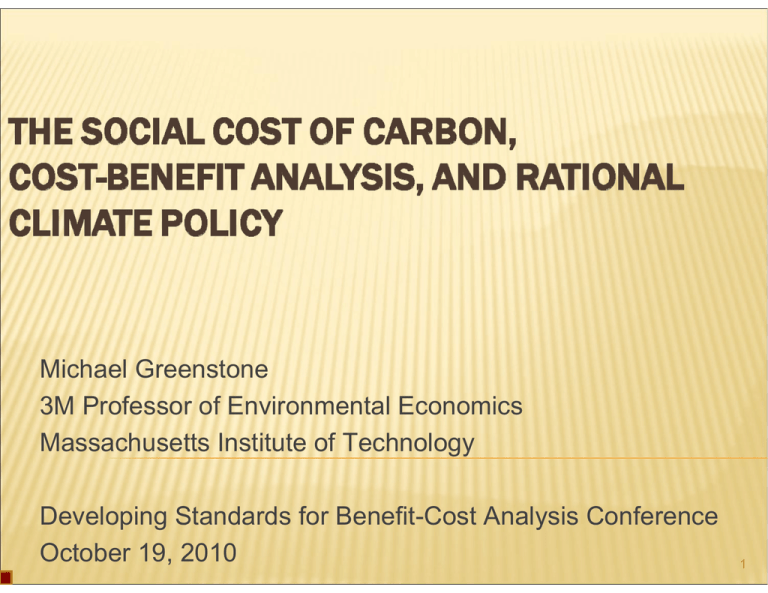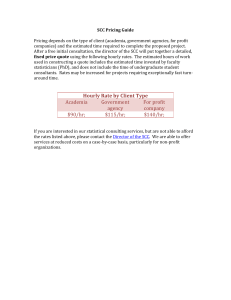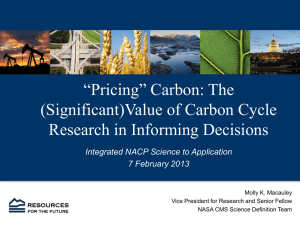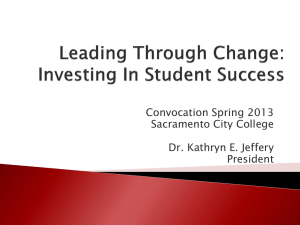Michael Greenstone 3M Professor of Environmental Economics Massachusetts Institute of Technology
advertisement

Michael Greenstone 3M Professor of Environmental Economics Massachusetts Institute of Technology Developing Standards for Benefit-Cost Analysis Conference October 19, 2010 1 Background & Motivation II. Social Cost Of Carbon (SCC) III. How is the SCC Calculated? IV. Lifetime Damages of a Ton of CO2 Emissions V. Results VI. Limitations VII. Conclusions I. 2 3 • Human-induced CO2 emissions will likely cause temperature increases • May have already begun Image removed due to copyright restrictions. To view the graph please go to the following website: http://www.worldclimatereport.com/index.php/2005/03/03/hockey-stick-1998­ 2005-rip/ 4 • Global temperatures projected to increase by 18% between 2000 and 2100 Image removed due to copyright restrictions. 5 80 60 40 20 0 <10 10-20 20-30 30-40 40-50 50-60 60-70 70-80 80-90 -20 -40 Distribution of Annual Daily Mean Temperatures (F) 1968-2002 Average Predicted Change, Hadley 3-A1FI, Error-Corrected >90 • GHG concentrations will reach dangerous levels without international action 8 ´ Many countries have signed the Copenhagen Accord to address climate change « U.S.: Agreed to reduce CO2 emissions to 17% below 2005 levels by 2020 « E.U.: CO2 to 20% below 1990 levels by 2020 « China: CO2/GDP to 40-45% below 1990 levels by 2020 « India: CO2/GDP to 20-25% below 1990 levels by 2020 9 Developing countries are more focused on economic development than emission reductions ´ Promised reductions in China and India are misleading ´ « Reducing emissions ´ CO2/GDP instead of actual CO2 Monitoring emissions reductions is difficult « Current technologies to monitor emissions are poor « Accord allows countries to self-monitor 10 House passed Waxman-Markey cap-and­ trade bill ´ Senate declined to pursue legislation ´ Best case in next several years: ´ « Renewable electricity standards « More subsidies for nuclear power 11 ´ EPA has finalized a “tailoring” rule for Greenhouse Gases (GHG) under the Clean Air Act to take effect in January 2011 Set Rules that Govern Behavior of 900 Largest Sources « Statute Requires Use of “Best Available Control Technology” « Likely to Be Endless Court Cases « -- Environmentalists say too weak -- States Question Legal Standing -- Clean Air Act Language Implies Many More Sources should be Covered (threshold of 100-250 tons per year versus 12 75,000-100,000 tons per year) ´ Likely Impact of Clean Air Act Regulations « Regulations Expected to Reduce Global Mean Temperature by only 0.006 to 0.0015 Degrees C by year 2100 « Reduce Atmospheric Concentrations of CO2 by 2.9 ppm « Reduce GHG Emissions by 5-12% in 2020, relative to 2005. President Promised 17% in Copenhagen 13 ´ Will these Regulations be Beneficial? «A regulatory impact analysis (RIA) will be required and informs the public of the relative costs and benefits of this mandate « Unclear if it will be necessary for benefits to exceed costs « Analyses will use the “social cost of carbon” to monetize the benefits stemming from CO2 reduction 14 15 ´ SCC: monetized damages associated with an incremental increase in carbon emissions in a given year ´ It includes but is not limited to changes in: « Net agricultural productivity « Human health « Property damages from increased flood risk « The value of ecosystem services 16 ´ DOE rule establishing energy conservation standards for beverage machines Benefits Class A Class B $37.7-44.2 million $4.1-4.9 million Costs Net Benefits, without SCC SCC Total Net Benefits 17 ´ DOE rule establishing energy conservation standards for beverage machines Class A Class B Benefits $37.7-44.2 million $4.1-4.9 million Costs $18.8-19.6 million $4.3-4.4 million Net Benefits, without SCC SCC Total Net Benefits 18 ´ DOE rule establishing energy conservation standards for beverage machines Class A Class B Benefits $37.7-44.2 million $4.1-4.9 million Costs $18.8-19.6 million $4.3-4.4 million Net Benefits, without SCC $18.1-25.4 million -$0.3-0.6 million SCC Total Net Benefits 19 ´ DOE rule establishing energy conservation standards for beverage machines Class A Class B Benefits $37.7-44.2 million $4.1-4.9 million Costs $18.8-19.6 million $4.3-4.4 million Net Benefits, without SCC $18.1-25.4 million -$0.3-0.6 million $7.9-9 million $1.1-1.3 million SCC Total Net Benefits 20 ´ DOE rule establishing energy conservation standards for beverage machines Class A Class B Benefits $37.7-44.2 million $4.1-4.9 million Costs $18.8-19.6 million $4.3-4.4 million Net Benefits, without SCC $18.1-25.4 million -$0.3-0.6 million $7.9-9 million $1.1-1.3 million $26-34.4 million $0.8-1.9 million SCC Total Net Benefits 21 22 ´ A USG interagency working group developed a transparent and economically rigorous way to estimate SCC ´ Now will Summarize Some of the Key Decisions and Results. (USG Plans to Revisit as Science Advances) 23 24 ´ ´ IAMs combine Climate Processes, Economic Growth, and Feedbacks between the Climate and the Global Economy into a single model Specifically, IAM translate changes in CO2 emissions into economic damages 1. Emissions [assumptions about GDP and population growth] 2. Emissions Æ Atmospheric GHG Concentrations [based on carbon cycle] 3. GHG Concentrations Æ Changes in Temperature [assumptions about climate model and climate sensitivity] 4. Temperature Æ Economic Damages (market and nonmarket) [assumptions about damage functions]�� 25 ´ Benefit of these Models is that they Answer Everything 26 ´ Benefit of these Models is that they Answer Everything ´ Cost of Models is that they Answer Everything 27 ´ Benefit of these Models is that they Answer Everything ´ Cost of Models is that they Answer Everything ´ Highly Dependent on Validity of Assumptions 28 ´ Relied on three commonly used IAM’s to estimate SCC: « FUND (Richard Tol) « DICE (William Nordhaus) « PAGE (Chris Page) All 3 are frequently cited in the peer-reviewed literature and used in the IPCC assessment ´ Each model is given equal weight to determine the SCC values ´ 29 30 31 ´ Socio-economic pathways are closely tied to climate damages « More and wealthier people tend to emit more GHG « Higher WTP to avoid climate disruptions ´ For this reason, decisions necessary for several input parameters from present until 2100: « Global GDP « Global Population « Global CO2 emissions 32 ´ Relied on the Stanford Energy Modeling Forum exercise, EMF-22 « Based on 4 of 10 models « Key advantage: ² GDP, population and emission trajectories are internally consistent « Five ²4 trajectories selected: business-as-usual (BAU) paths ¹ ²1 Correspond to 2100 concentrations of 612 – 889 ppm, reflecting differences in assumptions about cost of low carbon energy sources lower-than-BAU path ¹ Achieves stabilization at 550 ppm in 2100 33 ´ Equilibrium climate sensitivity (ECS): longterm increase in the annual global-average surface temperature due to a doubling of atmospheric CO2 concentration relative to pre-industrial levels « Equivalent to the atmospheric CO2 concentration stabilizing at about 550 parts per million (ppm) 34 ´ According to the Fourth Assessment Report of the Intergovernmental Panel on Climate Change (IPCC): We conclude that the global mean equilibrium warming for doubling CO2 … is likely to lie in the range 2°C to 4.5°C, with a most likely value of about 3 °C. Equilibrium climate sensitivity is very likely larger than 1.5 °C.… For fundamental physical reasons as well as data limitations, values substantially higher than 4.5 °C still cannot be excluded, but agreement with observations and proxy data is generally worse for those high values than for values in the 2 °C to 4.5 °C range.�� 35 t ´ Selected four candidate probability distributions and calibrated them to the IPCC statement: Roe and Baker (2007) « Log-normal « Gamma « Weibull « ´ Calibration done by applying three constraints: Median equal to 3°C « Two-thirds probability that ECS lies between 2 and 4.5°C « Zero probability that ECS is less than 0°C or greater than 10°C « 36 Table 1: Summary Statistics for Four Calibrated Climate Sensitivity Distributions Roe & Baker 0.013 Log‐normal Gamma Weibull 0.050 0.070 0.102 Pr(2°C < ECS < 4.5°C) 5th percentile 0.667 0.667 0.667 0.667 1.72 1.49 1.37 1.13 Median 3.00 3.00 3.00 3.00 Mean 3.50 3.28 3.19 3.07 95th percentile 7.14 5.97 5.59 5.17 Pr(ECS < 1.5°C) 37 ´ Selected the Roe and Baker distribution: « Only distribution based on a theoretical understanding of the response of the climate system to increased GHG concentrations « Most consistent with IPCC judgments regarding climate sensitivity: ² “Values substantially higher than 4.5°C still cannot be excluded” ² ECS “is very likely larger than 1.5°C” 38 ´ Current OMB guidance says Domestic Perspective is Mandatory and International Perspective is Optional ´ Determined that a Global Measure of the Benefits from Reducing U.S. Emissions is Preferable: « « « « Global Externality. Emissions in U.S. Cause Damages Around the World The U.S. cannot mitigate climate change by itself Decided against equity weighting that would place a greater weight on losses in poor countries NB: Best available evidence is that US damages are 5­ 15% of global damages . 3 40 ´ Half Life of a Ton of CO2 Emitted is 100 Years ´ Ton of Emissions Today will Affect Temperatures and Damages for a Long Period ´ Net Present Value of Damage due to Ton of Emissions Today Equals the Sum of the Discounted Value of the Damages Each Year Until It Has Disappeared from Atmosphere ² The Choice of Discount Rate is a Key Factor 41 Choice of a discount rate, especially over long periods of time, raises difficult questions ´ USG traditionally employs constant discount rates of both 3 percent and 7 percent ´ 42 ´ Two main approaches to determine the discount rate for climate change analysis approach is based on observations of people’s actual choices « Descriptive ² Savings versus consumption decisions over time ² Allocations of savings among more and less risky investments approach incorporates the decisionmaker’s normative judgments « Prescriptive ² How interpersonal comparisons of utility should be made ² How the welfare of future generations should be weighted against that of the present generation 43 Risk-free interest rate is used for discounting certain future benefits or costs ´ Benefits calculated by IAM’s are uncertain. ´ Market Rates should be used because the alternative is that society sets aside resources today for compensation and market rates would govern these returns. ´ 44 ´ Might expect a positive correlation between market returns and net benefits from climate policies « Most impacts of climate change will flow through agriculture and energy sectors « WTP for environmental protections increases with income « Proper discount rate would exceed the riskless rate ´ Alternatively, a negative correlation would necessitate a discount rate below the riskless rate 45 ´ Analyst selects the key parameters of the Ramsey equation: « η (coefficient of relative risk aversion) ² « Most papers in the literature adopt values in the range of 0.5 to 3 ρ (pure rate of time preference) Most papers in the literature adopt values in the range of 0 to 3 percent per year ² Very low rates, for example ρ = 0, tend to follow from moral judgments involving intergenerational neutrality ² ´ Combined with g (growth rate of per-capita consumption) to generate discount rate: β = ρ + η·g « Typical to assume 2, 2, 2, and have β = 6% « 46 Discount rate is uncertain over time ´ If there is a persistent element to this uncertainty, the effective discount rate will decline over time (e.g., Weitzman 1998, 1999, and 2001; Newell and Pizer 2003) ´ Methods to Account for this Uncertainty are being Developed ´ 47 ´ In light of the above considerations, USG used three discount rates: « Low Value: 2.5 percent ² ² ² « Central Value: 3 percent ² ² « Consistent with estimates in the literature and OMB’s guidelines for the consumption rate of interest Roughly corresponds to the after-tax riskless rate High Value: 5 percent ² ² ´ Interest rates are highly uncertain over time If climate investments are negatively correlated with market returns Incorporates normative objections to rates of 3 percent or higher If climate investments are positively correlated with market returns May be justified by the high interest rates many consumers use to smooth consumption Approach is largely descriptive and uses constant discount rates, but incorporates some key prescriptive concerns 48 ´ Running the models produces 45 separate distributions of the SCC for a given year « (3 models) x (5 socioeconomic scenarios) x (1 climate sensitivity distribution) x (3 discount rates) ´ The distributions from each of the models and scenarios are averaged together for each year « Produces three separate probability distributions for SCC in a given year, one for each discount rate 49 ´ For each IAM, here are steps for calculating the SCC: 1. Start with baseline socioeconomics and calculate the temperature and damages in each year 2. In year t, add an additional ton of CO2 emissions 3. Recalculate the temperature effects and damages in all years beyond t that resulted in step 1 4. Subtract the time path of damages in step 1 from those in step 3. This is the time path of marginal damages 5. Use the discount rate to calculate the SCC as the net present value of the marginal damages calculated in step 4 50 51 ´ USG selected four SCC estimates for use in regulatory analyses In 2010, these estimates are $5, $21, $35 & $65 (in 2007 US$) « First three estimates are the average SCC across 3 models & 5 emissions scenarios for 3 distinct discount rates « The fourth value represents higher-than-expected impacts « ² « Use the SCC value for the 95th percentile at a 3 percent discount rate The $21 estimate associated with a 3% discount rate is the central value 52 Table 3: Disaggregated Social Cost of CO2 Values by Model, Socio- Economic Trajectory, and Discount Rate for 2010 (in 2007 dollars) 53 Higher discount rates result in lower SCC values, and vice versa ´ There are clear differences in the SCC estimated across the three main models ´ « FUND produces the lowest estimates « PAGE produces the highest estimates Results match up fairly well with model estimates in the existing literature ´ The SCC increases over time ´ « Physical stressed and economic systems will become more 54 Figure 3: Social Cost of CO2, 2010 – 2050 (in 2007 dollars) 55 56 A. Incomplete treatment of non-catastrophic damages « IAM’s do not incorporate all the important physical, ecological, and economic impacts of climate change ² Lack of precise information on the nature of damages ² Damage function components differ between models « Even in future applications, a number of important damage categories will remain non-monetized ² Ocean acidification ² Species and wildlife loss 57 B. Incomplete treatment of potential catastrophic damages ² Potentially discontinuous “tipping point” behavior in Earth systems ² Inter-sectoral and inter-regional interactions that could lead to national security problems ² Limited substitutability between damages to natural systems and increased consumption 58 1. Tipping points « Damage functions are typically calibrated by estimating damages at moderate temperature increases (e.g., 2.5°C) « There exist potential climatic “tipping points” at which the Earth system may exhibit discontinuous behavior (e.g., collapse of West Antarctic Ice Sheet or large release of methane from melting permafrost) « Many of these tipping points are estimated to have thresholds between about 3°C and 5°C 59 2. Inter-sectoral and inter-regional interactions « E.g., damages to the agricultural sector are incorporated, but the effects of changes in food supply on human health are not « Effects of climate damages in one region of the world on another region are not included in some models « Inter-regional interactions are the basis for climate- induced national and economic security concerns 60 3. Imperfect substitutability of environmental amenities « IAM’s assume that it is possible to compensate for the damages to natural systems through increased consumption of non-climate goods « Damages to natural systems could become so great that no increase in consumption of non-climate goods would fully compensate ² e.g., if the water supply were to dwindle significantly 61 C. Incomplete treatment of adaptation and technological change « IAM’s assume low- or no-cost adaptation, which may not be realistic in some cases « IAM’s do not account for investment in adaptive technologies ² E.g., assume that farmers will change land use practices, but do not incorporate associated technological changes ² Also, do not account for increases in climate variability, pests, or diseases « Difficult to determine whether this incomplete treatment under or overstates the likely damages 62 D. Risk aversion « IAM’s assume risk-neutrality, even though most people are risk-averse « According to Anthoff et al (2009): “The assumed rate of risk aversion is at least as important as the assumed rate of time preference in determining the social cost of carbon” 63 64 ´ The SCC offers a way to measure the economic value of emissions reductions ´ The use of the SCC to guide GHG regulations under the Clean Air Act offers the possibility of achieving regulations where the benefits exceed the costs 65 ´ Key areas for future research include: « Improvements in how IAM’s capture catastrophic impacts « More attention to how predicted physical impacts translate into economic damages « More complete treatment of adaptation and technological changes « The role of the discount rate in a context where costs and benefits occur on different time horizons « A methodology for valuing reductions in other GHG’s 66 ´ Uncertainty « « ´ Which human beings will be harmed, where & by how much? What weight should those harms have in the cost-benefit calculation? Politics « Optimal U.S. climate regulation depends on what other countries do Largely due to the possibility of leakage ² Cost-benefit analysis cannot predict how other countries will behave ² « U.S. climate regulation will affect the well-being of many more foreigners than Americans There is no agreed-upon convention for evaluating the SCC of foreigners ² The right approach depends on normative questions that are prior to cost-benefit analysis ² 67 ´ Utilizing an unbalanced set of initial conditions « « ´ Employing three mutually inconsistent models « ´ Of the 4 BAU socio-economic trajectories, one corresponds to a relatively optimistic scenario None use a pessimistic scenario to balance it out “It seems likely that one of the three models is simply incorrect and is skewing the overall results improperly” Assuming that SCC is linear in emissions reduced « « “The relationship between global temperature changes and economic harm is likely nonlinear” Difficult to evaluate the benefits of large reductions 68 MIT OpenCourseWare http://ocw.mit.edu 11.202 Planning Economics Fall 2010 For information about citing these materials or our Terms of Use, visit: http://ocw.mit.edu/terms.





